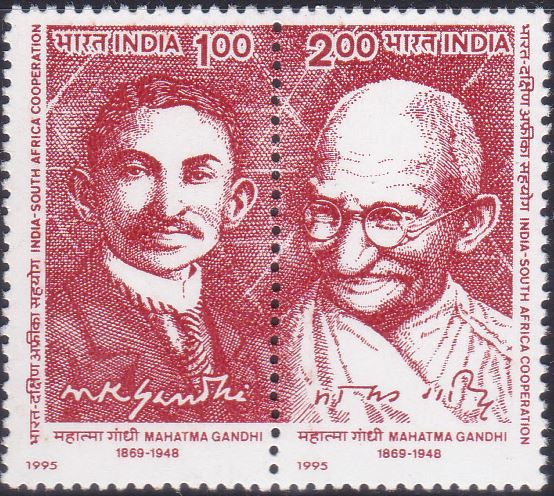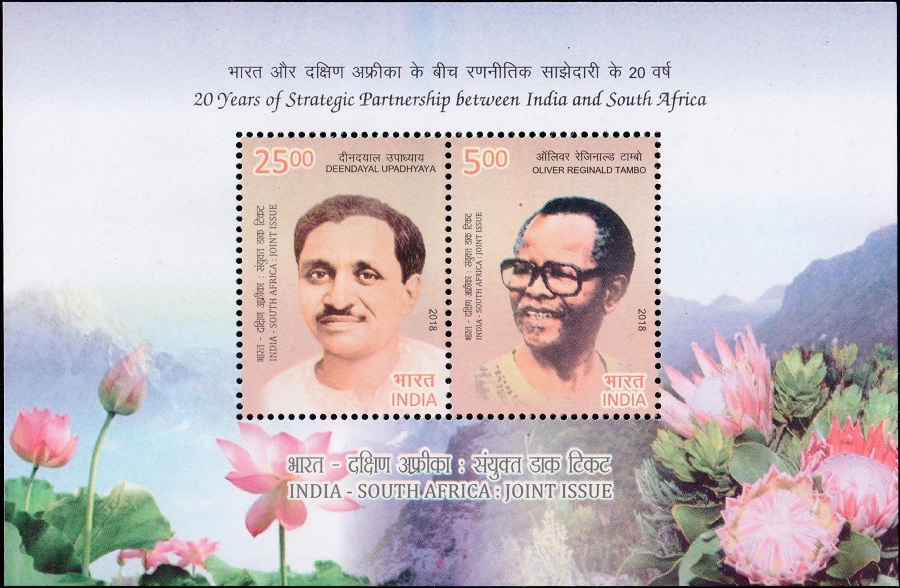
India-South Africa Cooperation 1995
Complete Set of 2 nos of postage stamps on Mahatma Gandhi‘s 125th Birth Anniversary (1869-1948) :
 Issued by India
Issued by India
Issued on Oct 2, 1995
Issued for : It is in order to recall this common heritage and the links forged by Mahatma Gandhi and there after by Nelson Mandela that the Department of Post has sought to release these commemorative stamps on 2nd October, 1995, on completion of the hundred and twenty fifth birth anniversary of Mahatma Gandhi. The cancellation is a line drawing of the Pietermaritzberg Railway Station at which Mahatma Gandhi‘s historic journey to satyagraha began.
Courtesy : Ministry of External Affairs; Shri M. V. Desai
Cancellation : Smt. Alka Sharma
Miniature Sheet : India Security Press, Nashik Road
Type : Se–tenant pair of 2 Stamps, Mint Condition
Colour : Single Colour
Denomination : 100 & 200 Paise
Overall size : 4.06 x 4.56 cms.
Printing size : 3.75 x 4.26 cms.
Perforation : 13 x 13
Paper : Imported un w/m Adhesive Gravure Coated Stamp Paper 53.5 x 50.8 cms.
Number of stamps Printed : 1.05 Million Each
Number per issue sheet : 35
Printing Process : Photogravure
Printer : India Security Press, Nasik
Name : Mohandas Karamchand Gandhi
Born on Oct 2, 1869 at Porbandar, Gujarat, India
Died on Jan 30, 1948 at New Delhi, India
About :
- Less than a hundred years ago, it was officially accepted and socially enforced that black, coloured and brown races should not mix with the white. Nor could they share with them the earth’s bounty and the good things of life. Fifty years later this practice took the legally enforced form of apartheid for those who, the ruling minority of South Africa thought, belonged to the lesser breeds. There were few who then thought this was wrong, fewer still who would undo this system’s injustice and immorality.
- But there was one Indian who believed such discrimination between one human being and another was immoral. He found himself among the ill-treated and discriminated people of South Africa. He backed up his beliefs with peaceful action and organised non-violent mass movements against racial laws. His methods were his own shorn of violence, vengefulness and hatred. He hated the immorality of the system with its discriminating laws but so loved the evildoer as to win him over.
- The experiments for which Mohandas Karamchand Gandhi created a fertile soil stood him in good stead during his later satyagrahas to awaken India to social equality, economic self-reliance and political freedoms. He worked up the moral sanctions which compelled the British to see the injustices of their rule and to quit India. This was the peaceful prelude to the winding up of the British in South Asia and Africa.
- Mahatma Gandhi‘s crusade against racist laws was taken up by the Africa National Congress. In Nelson Mandela it found a leader who thinks reconciliation is to be preferred to recrimination and vengeance for past wrongs. He now heads a government of national reconstruction which seeks to provide an African and human answer to the challenges bequeathed to India by Mahatma Gandhi. In Nelson Mandela, India finds an inspiration which is Mahatma Gandhi‘s legacy to the whole world which, Indians have believed and practised for hundred of years, makes up the single family of humankind. Reaffirming faith in oneself and in Gandhi‘s legacy, President Mandela described the essence of Gandhiji as “the moral force he extols, the goodness he invokes, the justice and balance with which he seeks to promote human society.“







